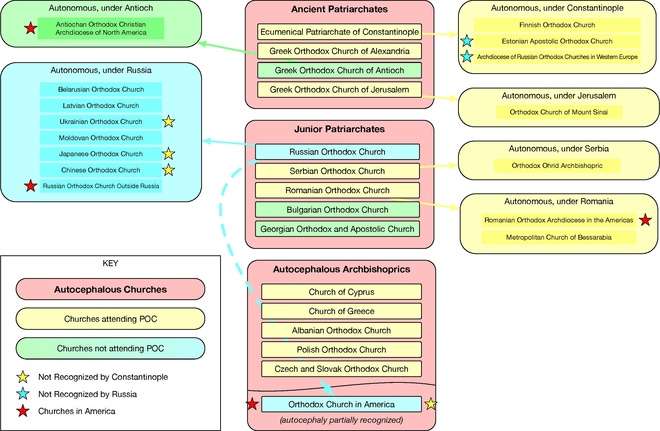Autocephaly
Autocephaly (/ˌɔːtəˈsɛfəli/; from Greek: αὐτοκεφαλία, meaning "property of being self-headed") is the status of a hierarchical Christian church whose head bishop does not report to any higher-ranking bishop. The term is primarily used in Eastern Orthodox and Oriental Orthodox churches. The status has been compared with that of the churches (provinces) within the Anglican Communion.[1]
Overview
In the first centuries of the history of the Christian church, the autocephalous status of a local church was promulgated by canons of the ecumenical councils. There developed the pentarchy, i.e. a model of ecclesiastical organization where the universal Church was governed by the primates (patriarchs) of the five major episcopal sees of the Roman Empire: Rome, Constantinople, Alexandria, Antioch, and Jerusalem.[2] Additionally, the Church of Lebanon, previously within the Church of Antioch, was granted full autocephaly in 685 AD by Pope Sergius I.[3][4] the Church of Cyprus, also previously within the Church of Antioch, was granted autocephaly by Canon VIII of the Council of Ephesus[5] It has since been governed by the Archbishop of Cyprus, who is not subject to any higher ecclesiastical authority.
The right to grant autocephaly is nowadays a contested issue, the main opponents in the dispute being the Ecumenical Patriarchate, which claims this right as its prerogative,[6][7] and the Russian Orthodox Church (the Moscow Patriarchate), which insists that an already established autocephaly has the right to grant independence to a part thereof.[8][9] Thus, the Orthodox Church in America was granted autocephaly in 1970 by the Moscow Patriarchate, but this new status was not recognized by most patriarchates.[10] In the modern era, the issue of autocephaly has been closely linked to the issue of self-determination and political independence of a nation; self-proclamation of autocephaly was normally followed by a long period of non-recognition and schism with the mother church.
Modern-era historical precedents
Following the establishment of an independent Greece in 1832, the Greek government in 1833 unilaterally proclaimed the Orthodox church in the kingdom (until then within the jurisdiction of the Ecumenical Patriarchate) to be autocephalous. But it was not until June 1850 that the Mother Church, under the Patriarch Anthimus IV, recognized this status.[11]
In May 1872, the Bulgarian Exarchate, set up by the Ottoman government two years prior, broke away from the Ecumenical Patriarchate, following the start of the people's struggle for national self-determination. The Bulgarian Church was recognized in 1945 as an autocephalous patriarchate, following the end of World War II and after decades of schism. By that time, Bulgaria was ruled by the Communist party and was behind the "Iron Curtain" of the Soviet Union.
Following the Congress of Berlin (1878), which established Serbia's political independence, full ecclesiastical independence for the Metropolitanate of Belgrade was negotiated and recognized by the Ecumenical Patriarchate in 1879. Additionally, in the course of the 1848 revolution, following the proclamation of the Serbian Vojvodina (Serbian Duchy) within the Austrian Empire in May 1848, the autocephalous Patriarchate of Karlovci was instituted by the Austrian government. It was abolished in 1920, shortly after the dissolution of Austria-Hungary in 1918 following the Great War. Vojvodina was then incorporated into the Kingdom of Serbs, Croats and Slovenes. The Patriarchate of Karlovci was merged into the newly united Serbian Orthodox Church under Patriarch Dimitrije residing in Belgrade, the capital of the new country that comprised all the Serb-populated lands. The united Serbian Church also incorporated the hitherto autonomous Church in Montenegro, whose independence had been formally abolished by Regent Alexander's decree in June 1920.
The autocephalous status of the Romanian Church, legally mandated by the local authorities in 1865, was recognized by the Ecumenical Patriarchate in 1885, following the international recognition of the independence of the United Principalities of Moldavia and Wallachia (later Kingdom of Romania) in 1878.[12]
In late March 1917, following the abdication of the Russian tsar Nicholas II earlier that month and the establishment of the Special Transcaucasian Committee, the bishops of the Russian Orthodox Church in Georgia, then within the Russian Empire, unilaterally proclaimed independence of the Georgian Orthodox Church. This was not recognized by the Moscow Patriarchate until 1943, nor by the Ecumenical Patriarchate until 1990.[13][14][15]
In September 1922, Albanian Orthodox clergy and laymen proclaimed autocephaly of the Church of Albania at the Great Congress in Berat. The church was recognized by the Ecumenical Patriarch of Constantinople in 1937.
The independent Kiev Patriarchate was proclaimed in 1992, shortly after the proclamation of independence of Ukraine and the dissolution of the USSR in 1991. The Moscow Patriarchate has condemned it as schismatic, as it claims jurisdiction over Ukraine. Other Orthodox churches have not yet recognized Ukraine as autocephalous. In 2018, the problem of autocephaly in Ukraine became a fiercely contested issue and a part of the overall geopolitical confrontation between Russia and Ukraine, as well as between the Moscow Patriarchate and the Ecumenical Patriarchate of Constantinople.[16][17][18]
A similar situation persists in North Macedonia, where the Macedonian Orthodox Church – Ohrid Archbishopric remains canonically unrecognized since 1967, when it split off from the Serbian Church and proclaimed autocephaly. The Serbian Church still maintains an autonomous Orthodox Ohrid Archbishopric in North Macedonia, which is recognised by all other Orthodox churches as the country's canonical local church.
Autonomy
One step short of autocephaly is autonomy. A church that is autonomous has its highest-ranking bishop, such as an archbishop or metropolitan, approved (or ordained) by the primate of the mother church, but is self-governing in all other respects. The modern Russian Orthodox Church (the Moscow patriarchate) also has the so called "self-governing churches", such as the Ukrainian Orthodox Church (Moscow Patriarchate), in addition to churches that it refers to as "autonomous," such as the Japanese Orthodox Church. Until 2011 these were not regarded as constituent parts of the Moscow Patriarchate.[19]
Kephale (κεφαλή) means "head" in Greek, whereas nomos (νόμος) means "law"; hence, autocephalous (αὐτοκέφαλος) denotes self-headed,[20] or a head unto itself, and autonomous denotes "self-legislated".
Autocephalous and autonomous churches

POC: Pan-Orthodox Council
References
Footnotes
- Avis 2016, p. 26; Gros, McManus & Riggs 1998, p. 176; Haselmayer 1948, p. 8; Lawrence 1963, p. 124.
- "Pentarchy" 2001.
- Saint John Maron
- No'man, Paul (1996). The Yesterday of the Maronite Church and it's Tomorrow (in Arabic). Ghosta: Books.CS1 maint: ref=harv (link)
- Schaff & Wace 1900, pp. 234–235.
- Erickson 1991.
- 1970 Letter from Ecumenical Patriarch Athenagoras on Autocephaly. / The letter of Ecumenical Patriarch Athenagoras of 24 June 1970 to Metropolitan Pimen, Locum Tenens of the Moscow Patriarchate, regarding the granting of autocephaly to the Orthodox Church in America.
- Sanderson 2005, p. 144.
- Jillions, John (7 April 2016). "The Tomos of Autocephaly: Forty-Six Years Later". Orthodox Church in America. Archived from the original on 15 June 2016. Retrieved 16 June 2018.
- Hovorun 2017, pp. 82, 126; Sanderson 2005, pp. 130, 144.
- Karagiannēs 1997, p. 24.
- Hitchins 1994, p. 92.
- Grdzelidze 2010, p. 172; Grdzelidze 2012, p. 61.
- "Автокефалия на волне революции: Грузинское православие в орбите Российской церкви". Nezavisimaya Gazeta (in Russian). 15 March 2017.
- "Αἱ λοιπαί Αὐτοκέφαλοι Ἐκκλησίαι: Ἐκκλησία τῆς Γεωργίας" [Other Autocephalous Churches: Church of Georgia] (in Greek). Istanbul: Ecumenical Patriarchate of Constantinople. Retrieved 15 January 2019.
- "Ecumenical Patriarch Takes Moscow Down a Peg over Church Relations with Ukraine". LB.ua. Kiev: Gorshenin Institute. 1 July 2018. Retrieved 15 January 2019.
- "Ecumenical Patriarch Bartholomew: 'As the Mother Church, It Is Reasonable to Desire the Restoration of Unity for the Divided Ecclesiastical Body in Ukraine'" (Press release). Istanbul: Ecumenical Patriarchate of Constantinople. 2 July 2018. Retrieved 15 January 2019.
- Satter, Raphael (27 August 2018). "Russian Cyberspies Spent Years Targeting Orthodox Clergy". Bloomberg News. Associated Press. Retrieved 15 January 2019.
- "Определение Освященного Архиерейского Собора Русской Православной Церкви "О внесении изменений и дополнений в Устав Русской Православной Церкви"" (in Russian). Moscow: Russian Orthodox Church. 5 February 2011.
- Erickson 1999, p. 132.
Bibliography
- Avis, Paul (2016). The Vocation of Anglicanism. London: T&T Clark. ISBN 978-0-567-66463-1.CS1 maint: ref=harv (link)
- Erickson, John H. (1991). The Challenge of Our Past: Studies in Orthodox Canon Law and Church History. Crestwood, New York: St. Vladimir's Seminary Press. ISBN 978-0-88141-086-0.CS1 maint: ref=harv (link)
- ——— (1999). Orthodox Christians in America: A Short History. New York: Oxford University Press (published 2010). ISBN 978-0-19-995132-1.CS1 maint: extra punctuation (link) CS1 maint: ref=harv (link)
- Grdzelidze, Tamara (2010). "The Orthodox Church of Georgia: Challenges Under Democracy and Freedom (1990–2009)". International Journal for the Study of the Christian Church. 10 (2–3): 160–175. doi:10.1080/1474225X.2010.487719. ISSN 1747-0234.CS1 maint: ref=harv (link)
- ——— (2012). "The Georgian Tradition". In Casiday, Augustine (ed.). The Orthodox Christian World. Abingdon, England: Routledge. pp. 58–65. ISBN 978-0-415-45516-9.CS1 maint: extra punctuation (link) CS1 maint: ref=harv (link)
- Gros, Jeffrey; McManus, Eamon; Riggs, Ann (1998). Introduction to Ecumenism. Mahwah, New Jersey: Paulist Press. ISBN 978-0-8091-3794-7.CS1 maint: ref=harv (link)
- Haselmayer, Louis A. (1948). Lambeth and Unity. New York: Morehouse-Gorham Co.CS1 maint: ref=harv (link)
- Hitchins, Keith (1994). Rumania 1866–1947. Oxford: Clarendon Press.CS1 maint: ref=harv (link)
- Hovorun, Cyril (2017). Scaffolds of the Church: Towards Poststructural Ecclesiology. Eugene, Oregon: Wipf and Stock Publishers. ISBN 978-1-5326-0753-0.CS1 maint: ref=harv (link)
- Karagiannēs, Giōrgos (1997). Ekklēsia kai kratos, 1833–1997: Historikē episkopēsē tōn scheseōn tous. To Pontiki (in Greek). Athens. ISBN 978-960-8402-49-2.CS1 maint: ref=harv (link)
- Lawrence, John (1963). "Anglicans and Orthodoxy". In Armstrong, A. H.; Fry, E. J. B. (eds.). Re-Discovering Eastern Christendom: Essays in Commemoration of Dom Bede Winslow. London: Darton Longman & Todd. pp. 119ff.CS1 maint: ref=harv (link)
- "Pentarchy". Encyclopædia Britannica. 2001. Retrieved 14 February 2010.
- Sanderson, Charles Wegener (2005). Autocephaly as a Function of Institutional Stability and Organizational Change in the Eastern Orthodox Church (PhD diss.). College Park, Maryland: University of Maryland, College Park. hdl:1903/2340.CS1 maint: ref=harv (link)
- Schaff, Philip; Wace, Henry, eds. (1900). A Select Library of the Nicene and Post-Nicene Fathers of the Christian Church. Series 2. Volume 14: The Seven Ecumenical Councils. Peabody, Massachusetts: Hendrickson Publishers (published 1995). ISBN 978-1-56563-130-4.CS1 maint: ref=harv (link)
Further reading
- "Autocephaly". OrthodoxWiki. Retrieved 16 June 2018.
- Papakonstantinou, Christoporos (1999). "Autocephaly". In Fahlbusch, Erwin; Lochman, Jan Milič; Mbiti, John; Pelikan, Jaroslav; Vischer, Lukas; Bromiley, Geoffrey W.; Barrett, David B. (eds.). Encyclopedia of Christianity. 1. Translated by Bromiley, Geoffrey W. Grand Rapids, Michigan: Wm. B. Eerdmans Publishing Company. p. 173. ISBN 978-0-8028-2413-4.
- Shahan, Thomas J. (1907). . In Herbermann, Charles G.; Pace, Edward A.; Pallen, Condé B.; Shahan, Thomas J.; Wynne, John J. (eds.). Catholic Encyclopedia. 2. New York: Encyclopedia Press (published 1913). pp. 142–143.
- Zhukovsky, Arkadii (1984). "Autocephaly". In Kubiyovych, Volodymyr (ed.). Encyclopedia of Ukraine. 1. Toronto: University of Toronto. pp. 141–142. ISBN 978-1-4426-3280-6.
